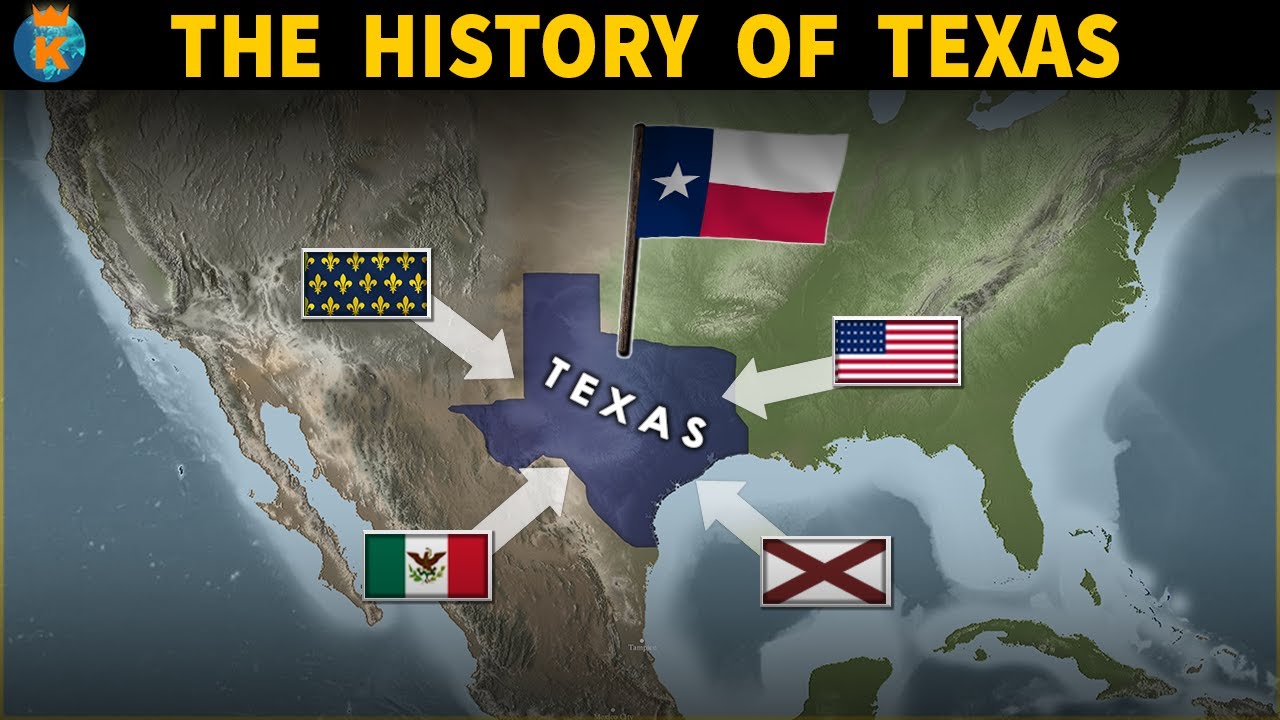Home of the fastest road in the USA, the largest state capitol building in the nation, and a mass bigger than any country in Europe – Texas has a history almost as large as everything in it… The history of the great state of Texas technically begins at around 9200 BC at least. Paleo-Indians were the early inhabitants of the territory and by the first AD years, Texas boasted a considerable indigenous population already. By the time the North American continent began to be colonized, there were about 6 main native cultural groups in Texas alone. This meant that the fate of the early European colonists would depend vastly on how the locals responded to their presence… The first European explorer to map the Texas Gulf Coast was Alonso Alvarez de Pineda in 1519, although it wouldn’t be for nearly another decade until a Spaniard actually journeyed into the North American interior, and thus, Texas. This next expedition began in 1528 under the lead of Panfilo de Narvaez but quickly turned into an utter disaster.
Hurricanes and savage storms battered the expedition and sunk two of the fleet’s ships, killing already a good chunk of the initial 600 men. The survivors were still aimed for a landing in modern-day Tampico, Mexico but as luck would have it, they were instead blown off course toward Florida, not far off from today’s Tampa Bay. Now, Narvaez opted to divide his troops into two groups – one on land and one still on the ships – to explore the northern coast of Florida. These expeditions were intended to meet up once more at an unspecified harbor, but yet again the plan would fail. There was no harbor where the fleet could dock and the 300 who had traveled by land were under siege from the local Indigenous tribes, as well as from starvation and disease.
These explorers were dying by the masses now and only a few months later, around 90 remained. Conditions were no better than thus far however and when the final group of explorers were swept onto Galveston Island, they were swiftly abducted by the Natives and more would continue to succumb to disease, starvation, and now the harsh conditions of their new situation.
Eight years later, 90 became 4… Alvar Nunez Cabeza de Vaca, Andres Dorantes de Carranza and his slave Estevanico, and Alonso del Castillo Maldonado were the only remaining members of Narvaez’s journey. The final survivors attempted on their own to explore what they could of the modern Southwestern portion of the United States and the very top of Mexico, but they would soon join ranks with a group of slave catchers they found in Sinaloa in 1536. Finally, the expedition would reach Mexico City, and eventually the few survivors left returned to their Spanish homes.
The French, however, were no less interested than Spain. While the Spaniards failed to follow up their early expeditions with the establishment of any real settlements, the French managed to do it without even intending to… It all started in the late 1600s when a French nobleman by the name of Robert Cavelier de La Salle decided to explore along the Mississippi River with the purpose of finding a way to create a better buffer between France’s North American territories and those belonging to Spain.
Stumbling across the Gulf of Mexico, La Salle would soon claim the whole of the Mississippi River Valley for France. After returning to France, he then attempted to convince the king to set up a settlement at the mouth of the Mississippi to help fend off the nearby Spaniards in addition to trying to convert more of the Indigenous population to French Christianity. When King Louis The fourteenth finally gave his approval, La Salle was sent back to begin the colony… Navigational faults would eventually lead La Salle to instead create a settlement further west off the coast of Mexico, but this colony would scarcely survive 3 years before finally succumbing to incursions from the Natives, disease, and other difficulties.
The Spanish would soon hear of the French colony nonetheless and decided that they should remove “this thorn which has been thrust into the heart of America” – however, the Karan-kawa and disease had already done so for them. Realizing the collapse of France’s settlement and the possibilities now to found a Spanish one, Alonso De Leon was sent off to first establish a mission in eastern Texas in 1690. This launched a period of on/off interest in Texas by Spain as clashes with the Natives seemed to continuously dissuade the Spaniards from doing much more. Real efforts appeared to only come in the early 18th century after a Franciscan missionary attempted to seek support from the French for establishing new missions in Texas. Spain would almost immediately move to reoccupy the territory and keep the French out, which they did fairly well.
At least, they were better at defending themselves from the French than from the local Indigenous. Though still at odds with various local tribes, in 1762 Spain was finally able to convince the French to relinquish all claims to the Texas territory at the end of the Seven Years’ War. The Mexican War of Independence would secure much of Spain’s former North American colonies as the new state of Mexico in 1821.

Texas, would be part of this infant country and the Mexican government quickly blasted open the door for immigration as they hoped to bring in more settlers to counteract the effects of the angry Natives. But, with the growing population also came growing unrest, and by 1836, a new Texas government was formed and a declaration of independence from Mexico followed.
The new Republic of Texas would host the infamous Battle of the Alamo in short order, a bloody massacre of Texas defenders that lit a passion under many Texans who now were even more determined to defeat the Mexicans.
The Texas Revolution subsequently would be successful in the end, although, the independence fighters opposing what they saw as the tyrannical rule of Mexico…soon voted in favor of becoming a part of the United States. Ironically, the latter didn’t even want Texas at first. Andrew Jackson and Martin Van Buren shot down the idea initially but pressure from Great Britain for Texas to remain sovereign frankly pushed the Americans toward annexation. Finally, in 1845, both congresses approved the move and Texas thus became a state of the U.
S.A. This, not surprisingly, triggered discord between America and Mexico over territorial disputes that would initiate the start of the Mexican-American War. Though, in the end, Mexico would technically receive money in exchange for the full American ownership of Texas as well as other ceded territories, there wasn’t much of an option left by the time the war was over. Originally, Texas had actually laid claim to these additional ceded territories, which are now part of modern-day Colorado, Wyoming, Kansas, Oklahoma, and New Mexico.
But, Texas would eventually relinquish these claims to the federal government with the Compromise of 1850 and barely over a decade later, in a drastic turn of events, Texas chose to leave the United States entirely… With the Civil War coming ever closer, a period of panic erupted in Texas, becoming known as the “Texas Troubles”. There had been rumors of enslaved people suddenly starting fires throughout the state which led to lynching mobs and a heavier push against the abolitionist beliefs of the union. This would eventually push Texas to hold a vote concerning secession from the United States, which found a whopping 76% of Texans in favor of leaving. As a result, Texas officially seceded and instead decided to join the Confederate States of America – a drastic change from its prior pleas to be annexed. Throughout the war, Texans who still even loosely supported or wished to be part of the Union faced severe consequences for their dissension, particularly those of the German and Mexican districts and in Cooke County in particular.
In the latter, over 100 union supporters were arrested while over 60 of those were executed. Civil War era Texas was plagued with such massacres of unionists and even after the Emancipation Proclamation and Juneteenth marked the end of the hostilities in one form, it also triggered a new wave of violence and outrage from Confederate veterans.
Nevertheless, Texas would officially rejoin the United States of America on March 30, 1870… The following phase of Texas’s history marked a time of difficult reconstruction. Racial divides caused the once-90% black Republican Party in Texas to lose power to the white Democrats. This also coincided with a new movement within the Republican Party that aimed to remove the freed slaves from power in the party, with all of this reflecting the overall ongoing black vs.
white conflict and racial violence throughout the former-Confederate state. These challenges would stretch into the 20th century as Texas struggled to stabilize itself socially within the union. Hurricanes, drought, and the JFK assassination would additionally plague the great state of Texas over the next century, making it a tough ride for Texans still..
Read More: The American Civil War: 1861 – 1865 | Documentary





